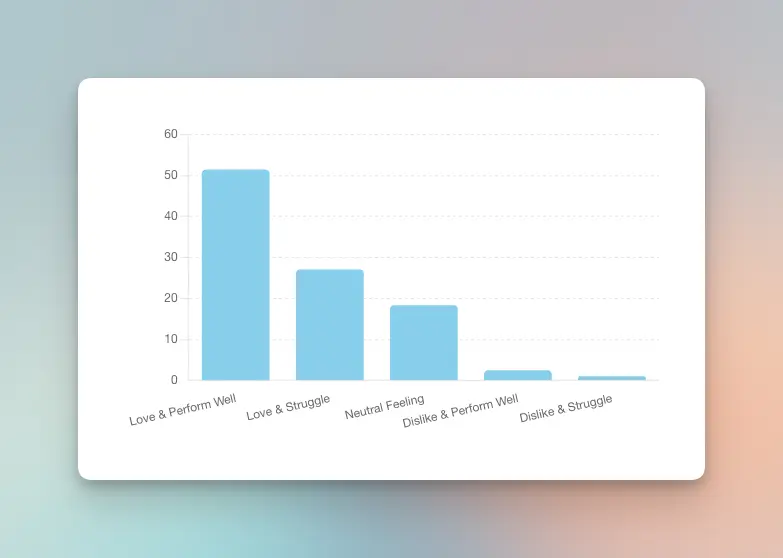In today’s competitive business landscape, understanding the nuances of employee sentiments toward their work and performance is more crucial than ever. A recent pulse survey asked employees, "How would you describe your feelings towards your job and your ability to perform it well?" provides valuable insights into how employees perceive their jobs and their ability to perform effectively. Analyzing quantitative and qualitative data reveals actionable strategies for leaders to enhance organizational culture and productivity. It also highlights self-empowerment strategies employees can adopt to improve their work experience.
Quantitative Findings: A Snapshot of Employee Sentiments
The survey asked employees to describe their feelings toward their jobs and their perceived ability to perform. Here's what the data reveals:
- Love & Perform Well: Most respondents (51.4%) express high satisfaction with their jobs and confidence in their performance. This group is a testament to strong engagement and organizational alignment.
- Love & Struggle: About 27% of employees love their jobs but face performance challenges, indicating opportunities for skill development and support.
- Neutral Feeling: 18.3% of respondents feel indifferent towards their job and performance, signaling a need for increased engagement.
- Dislike & Perform Well: A small segment (2.4%) is dissatisfied despite performing well, often due to misaligned values or lack of recognition.
- Dislike & Struggle: The smallest group (0.9%) struggles with both dissatisfaction and performance issues, requiring immediate attention.

These figures provide a baseline understanding of employee sentiments but also prompt further exploration into underlying factors affecting these perceptions.
Additional Quantitative Insights
The analysis of the survey responses provides further quantitative insights into the workplace environment:
- Engagement Levels: The high percentage of employees who love their jobs and perform well indicates strong engagement within the organization. Maintaining this level of engagement requires continuous support and opportunities for professional growth.
- Potential for Improvement: The sizeable portion of employees who love their jobs but struggle highlights areas where targeted training and development programs can be implemented to improve performance.
- Areas of Concern: The small groups expressing dissatisfaction, particularly those who dislike their jobs despite performing well, require strategic interventions to address underlying issues and prevent disengagement.
- Neutral Sentiments: The group with neutral feelings towards their jobs presents an opportunity to explore new ways to engage and motivate employees, ensuring they find fulfillment and satisfaction in their roles.
Qualitative Insights: Unveiling the Underlying Themes
Delving into the qualitative responses gives us a deeper understanding of the factors influencing employee attitudes. Here are the key themes:
Love & Perform Well: Strategies for Sustaining High Engagement
Organizational Recommendations:
Employees in this category emphasize the importance of continuous improvement and work-life balance. They cite strategies like ongoing skill development, effective time management, and maintaining a positive attitude as key to their sustained performance and passion. For CEOs and HR leaders, fostering an environment encouraging continuous learning and recognizing achievements can help maintain this positive momentum.
Employee Recommendations:
- Continuous Learning: Proactively seek out learning opportunities through workshops, online courses, or mentorship.
- Time Management: Develop personal systems for prioritizing tasks and setting boundaries to maintain work-life balance.
- Self-Care: Regularly engage in activities that promote well-being, such as exercise or meditation.
Dislike & Perform Well: Addressing the Misalignment
Organizational Recommendations:
This group performs well but feels disengaged, primarily due to a lack of recognition and misalignment with personal values. Leaders should recognize contributions and ensure that roles align with employees' values and career aspirations. Building a culture of recognition and providing opportunities for meaningful work can mitigate dissatisfaction.
Employee Recommendations:
- Seek Feedback: Actively request feedback from peers and supervisors to gain insights into how you can align your strengths with organizational goals.
- Clarify Values: Reflect on personal values and seek projects or roles that align with them.
- Express Needs: Communicate with management about what recognition or support would enhance your job satisfaction.
Love & Struggle: Bridging the Gap Between Passion and Performance
Organizational Recommendations:
Employees who love their jobs but struggle with performance often seek skill development and feedback. Encouraging regular feedback loops, offering targeted training programs, and setting clear, achievable goals can help bridge the gap between passion and performance.
Employee Recommendations:
- Skill Enhancement: Identify specific skills that need improvement and pursue targeted learning opportunities.
- Goal Setting: Set personal goals and track progress to stay motivated and focused.
- Peer Support: Collaborate with colleagues who can offer guidance and share best practices.
Neutral Feeling: Engaging the Indifferent
Organizational Recommendations:
For those with neutral feelings, changes that enhance career development and job enrichment are vital. This includes providing clear career pathways, increasing managerial support, and diversifying job responsibilities. Effective communication and engagement initiatives can also transform indifference into enthusiasm.
Employee Recommendations:
- Explore New Opportunities: Seek out new projects within the organization that align with your interests.
- Self-Reflection: Regularly assess job satisfaction and identify what changes might improve it.
- Proactive Engagement: Take initiative to engage with team members and leadership to discuss career aspirations.
Dislike & Struggle: Transforming Challenges into Opportunities
Organizational Recommendations:
This group faces both dissatisfaction and performance challenges, often due to a lack of support and overwhelming workloads. Addressing these issues requires a holistic approach, creating a supportive work environment, optimizing workloads, and ensuring access to necessary resources. Transforming a demotivating environment into a supportive and engaging one is crucial for this group.
Employee Recommendations:
- Identify Challenges: Clearly identify specific challenges impacting performance and satisfaction.
- Seek Solutions: Collaborate with managers to find practical solutions and support systems.
- Prioritize Well-being: Focus on self-care and stress management techniques to maintain mental health.
Strategic Implications for Leaders
These insights underscore the importance of a multifaceted approach to employee engagement. Here are actionable strategies for CEOs and HR leaders:
- Foster Continuous Development: Encourage ongoing learning and development opportunities tailored to individual needs and aspirations.
- Recognize and Reward Contributions: Implement recognition programs that align with company values and individual contributions.
- Enhance Job Alignment: Regularly review roles and responsibilities to ensure alignment with employees' values and strengths.
- Promote Work-Life Balance: Encourage a culture that values personal well-being alongside professional achievements.
- Cultivate Open Communication: Establish transparent communication channels to gather feedback and involve employees in decision-making.
By leveraging these insights, leaders can cultivate a work environment that attracts, retains, and nurtures top talent, ultimately driving organizational success.
Conclusion
Understanding employee sentiments through quantitative and qualitative metrics offers a comprehensive view of workplace dynamics. Organizations can foster a culture of engagement and high performance by addressing the specific needs and challenges identified in each employee segment. Empowering employees to take initiative in their professional growth is equally vital. For CEOs and HR leaders, this approach is not just about improving morale—it's about building a sustainable and thriving workplace for the future.









